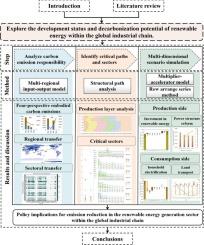Carbon footprints and decarbonization potential in the global renewable power sector
IF 9.6
1区 环境科学与生态学
Q1 ENVIRONMENTAL STUDIES
引用次数: 0
Abstract
The renewable energy power sector is widely recognized as a key driver of decarbonization, while few studies have systematically examined its embodied carbon emissions and decarbonization potential within the context of global industrial chain. This study addressed this critical gap by integrating the multi-regional input-output model, structural path analysis, multiplier-accelerator model, and row arrangement series method to investigate the embodied carbon emissions characteristics and decarbonization potential of this sector within the global industrial chain. The research findings reveal that: (i) the embodied carbon emissions at the consumption end of renewable energy increased significantly by 46.40 % from 2016 to 2022. (ii) China and the United States hold pivotal roles in the industrial chain. The typical embodied carbon emissions transmission path flows from local renewable generation to heavy industry sectors, then to end-users either directly or via intermediaries. (iii) Environmentally-friendly residential power supply and power structure optimization scenarios have substantial emission reduction effects, achieving maximum emission reductions of 1202.99 Mt. and 1156.04 Mt. (iv) The power supply structure significantly influences the carbon reduction effects of land transportation transformation. When the proportion of renewable energy is <50 %, emissions increase; however, when the renewable energy ratio reaches two-thirds, emissions can be obviously reduced by 17,157.36 kt. (v) The initial investments in renewable energy may lead to a marginal 0.30 % increase in embodied carbon emissions. These findings support the formulation of tailored policies for the low-carbon development of renewable energy across the global industrial chain, thereby providing crucial guidance for the global transition to a green energy system.

全球可再生能源行业的碳足迹和脱碳潜力
可再生能源电力行业被广泛认为是脱碳的关键驱动力,但很少有研究系统地考察其在全球产业链背景下的隐含碳排放量和脱碳潜力。本研究通过整合多区域投入产出模型、结构路径分析、乘数加速器模型和排列序列方法,研究了该行业在全球产业链中的隐含碳排放特征和脱碳潜力,解决了这一关键缺口。研究结果表明:(1)2016 - 2022年可再生能源消费端隐含碳排放量显著增长46.40%。(二)中美两国在产业链上处于举足轻重的地位。典型的隐含碳排放传输路径是从当地可再生能源发电到重工业部门,然后直接或通过中介流向最终用户。(三)环境友好型住宅供电和电力结构优化场景减排效果显著,最大减排量分别为1202.99 Mt和1156.04 Mt。(四)供电结构显著影响陆上交通转型的减碳效果。当可再生能源占比为50%时,排放量增加;然而,当可再生能源比例达到三分之二时,排放量可明显减少17,157.36 kt。对可再生能源的初始投资可能导致实际碳排放量增加0.30%。这些发现有助于制定有针对性的政策,促进全球可再生能源产业链的低碳发展,从而为全球向绿色能源体系转型提供重要指导。
本文章由计算机程序翻译,如有差异,请以英文原文为准。
求助全文
约1分钟内获得全文
求助全文
来源期刊

Sustainable Production and Consumption
Environmental Science-Environmental Engineering
CiteScore
17.40
自引率
7.40%
发文量
389
审稿时长
13 days
期刊介绍:
Sustainable production and consumption refers to the production and utilization of goods and services in a way that benefits society, is economically viable, and has minimal environmental impact throughout its entire lifespan. Our journal is dedicated to publishing top-notch interdisciplinary research and practical studies in this emerging field. We take a distinctive approach by examining the interplay between technology, consumption patterns, and policy to identify sustainable solutions for both production and consumption systems.
 求助内容:
求助内容: 应助结果提醒方式:
应助结果提醒方式:


